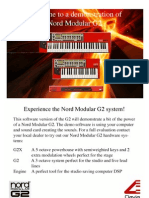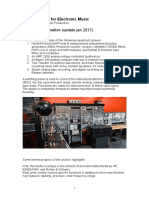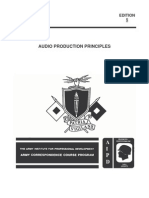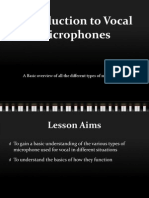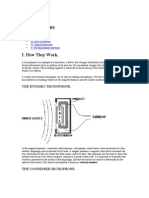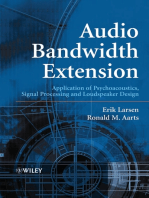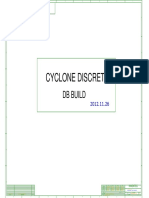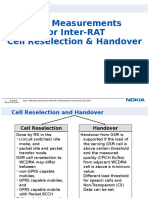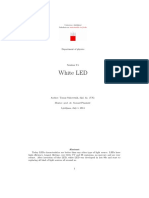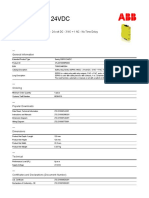The Ambisonic Decoder Toolbox: Extensions For Partial Coverage Loudspeaker Arrays
The Ambisonic Decoder Toolbox: Extensions For Partial Coverage Loudspeaker Arrays
Uploaded by
Aaron J. HellerCopyright:
Available Formats
The Ambisonic Decoder Toolbox: Extensions For Partial Coverage Loudspeaker Arrays
The Ambisonic Decoder Toolbox: Extensions For Partial Coverage Loudspeaker Arrays
Uploaded by
Aaron J. HellerOriginal Description:
Original Title
Copyright
Available Formats
Share this document
Did you find this document useful?
Is this content inappropriate?
Copyright:
Available Formats
The Ambisonic Decoder Toolbox: Extensions For Partial Coverage Loudspeaker Arrays
The Ambisonic Decoder Toolbox: Extensions For Partial Coverage Loudspeaker Arrays
Uploaded by
Aaron J. HellerCopyright:
Available Formats
THE AMBISONIC DECODER TOOLBOX:
EXTENSIONS FOR PARTIAL COVERAGE
LOUDSPEAKER ARRAYS
Aaron J. Heller, AI Center, SRI International, Menlo Park, CA US
Eric M. Benjamin, Surround Research, Pacifica, CA US
Linux Audio Conference, May 3, 2014
What is Ambisonics?
Extensible, hierarchical system for representing sound
fields
Says how something should sound, rather than specific speaker
signals.
Capture or creation
Microphone arrays
2-D or 3-D
Natural B-format, Tetrahedral, Spherical arrays
Ambisonic Panners
Reproduction
2-D, horizontal or 3-D with height loudspeaker arrays
Any size or shape array of loudspeakers
Heller, Benjamin, The Ambisonic Decoder Toolbox, Linux Audio Conference 2014, ZKM, Karlsruhe, Germany
What is an Ambisonic Decoder?
In Ambisonics, the program format is independent of the
reproduction layout.
The decoders task is to create the best perceptual
impression possible that the sound field is being
reproduced accurately, given the resources available
Bandwidth, number of speakers, configuration of speakers
We use the term decoder to mean the configuration for a
decoding engine that does the actual signal processing
Heller, Benjamin, The Ambisonic Decoder Toolbox, Linux Audio Conference 2014, ZKM, Karlsruhe, Germany
Goals for decoder design
Mimic conditions of natural hearing
Constant amplitude gain for all source directions (P)
Constant energy gain for all source directions (E)
At low frequencies, correct reproduced wavefront direction and
velocity (rV)
At high frequencies, maximum concentration of energy in the
source direction (rE)
Matching high- and low-frequency perceived directions
Getting rE correct is the most difficult aspect
Recent work shows that it is also the most important!
Heller, Benjamin, The Ambisonic Decoder Toolbox, Linux Audio Conference 2014, ZKM, Karlsruhe, Germany
Designing Decoders
Decoders for regular polygon and polyhedra loudspeaker
arrays are easy to design
Build the speaker encoding matrix, K, by sampling the spherical
harmonics at the speaker directions
Use pseudoinverse to find the basic decoding matrix M
rE guaranteed to point in same direction as rV
However
Room geometry or visual considerations often limit speaker
placement
3-D HOA requires placing more speakers above and below the
listener
Heller, Benjamin, The Ambisonic Decoder Toolbox, Linux Audio Conference 2014, ZKM, Karlsruhe, Germany
How youd like to do it
AuraLab, San Francisco
Heller, Benjamin, The Ambisonic Decoder Toolbox, Linux Audio Conference 2014, ZKM, Karlsruhe, Germany
A useful compromise
The Bubble, San Francisco
Heller, Benjamin, The Ambisonic Decoder Toolbox, Linux Audio Conference 2014, ZKM, Karlsruhe, Germany
Tradeoffs
Once we deviate from regular geometry
we must trade off localization accuracy for uniform loudness
Directions of rE and rV are not the same
Localization degrades outside the area with a high density
of loudspeakers
Gerzon used nonlinear optimization for this
Many implementations: Wiggins, Moore & Wakefield, Tsang, BLaH
Works well for small arrays (e.g., ITU 5.1)
Convergence is slow for large HOA arrays (hrs)
IDHOA (Scaini and Arteaga) looks promising
Better objective function and zero out small coefficients
Heller, Benjamin, The Ambisonic Decoder Toolbox, Linux Audio Conference 2014, ZKM, Karlsruhe, Germany
New Strategies in Toolbox
Use an inversion technique suited to ill-conditioned
matrices
Constant energy decoder
Truncated SVD
Energy limited
Invert a well-behaved full-sphere virtual speaker array,
map to a real array
Hybrid Ambisonic-VBAP
AllRAD (Zotter and Frank)
Derive a new set of basis functions for which inversion is
well behaved
Spherical Slepian Functions
EPAD (Zotter, Pomberger, Noisternig)
Heller, Benjamin, The Ambisonic Decoder Toolbox, Linux Audio Conference 2014, ZKM, Karlsruhe, Germany
Are these decoders Ambisonic?
Ambisonic theory specifies performance goals, not how to
design a decoder
We use the same criteria for these decoders
But
Apply them only to source directions in the covered part of the sphere
Require them be well behaved in other directions
3rd order Hybrid Ambi-VBAP (AllRAD)
50
50
0.8
0
0.7
-50
0.6
Azimuth HdegreesL
-150 -100
-50
50
100
0.5
150
HaL rE vs. Test Direction
-6
-4
-2
0246
10
4
-50
Elevation HdegreesL
0.9
Elevation HdegreesL
Elevation HdegreesL
10
-2
50
-4
-6
-50
2
Azimuth HdegreesL
-150 -100
-50
50
100
150
HbL rE Direction Error HdegreesL
-6
-4
-2
0246
-8
Azimuth HdegreesL
-150 -100
-50
50
100
150
HcL Energy Gain HdBL
-10
-6
-4
-2
0246
11
CCRMA Listening Room
22 identical loudspeakers in
five rings
Horizontal ring of 8
loudspeakers
2 rings of 6 loudspeakers,
one 50 below horizontal and
one 40 above
1 loudspeaker at each pole
Array is almost regular
Upper 15 used for
hemispherical dome
Full-sphere decoder
described in our LAC2012
paper
Heller, Benjamin, The Ambisonic Decoder Toolbox, Linux Audio Conference 2014, ZKM, Karlsruhe, Germany
12
AllRAD Hybrid Ambi-VBAP
240 point spherical
design for virtual
speaker array
Dome of upper 15
loudspeakers of
CCRMA Listening
Room, 8-6-1
Imaginary speaker
at bottom
Design procedure
detailed in paper
Heller, Benjamin, The Ambisonic Decoder Toolbox, Linux Audio Conference 2014, ZKM, Karlsruhe, Germany
13
AllRAD performance rv
Heller, Benjamin, The Ambisonic Decoder Toolbox, Linux Audio Conference 2014, ZKM, Karlsruhe, Germany
14
AllRAD performance rE
Heller, Benjamin, The Ambisonic Decoder Toolbox, Linux Audio Conference 2014, ZKM, Karlsruhe, Germany
15
AllRAD rv direction grid
Heller, Benjamin, The Ambisonic Decoder Toolbox, Linux Audio Conference 2014, ZKM, Karlsruhe, Germany
16
AllRAD rE direction grid
Heller, Benjamin, The Ambisonic Decoder Toolbox, Linux Audio Conference 2014, ZKM, Karlsruhe, Germany
17
Heller, Benjamin, The Ambisonic Decoder Toolbox, Linux Audio Conference 2014, ZKM, Karlsruhe, Germany
18
Spherical Slepian Functions
Linear combinations of spherical harmonics
Produce a new set of basis functions that are zero outside
the region of interest on the sphere
Remain orthogonal within the region
Used in satellite geodesy to model earths gravitational
and magnetic fields from incomplete data
In Ambisonic decoding, we can specify a region of the
sphere, a dome or a ring, and derive a well behaved set of
basis functions for that region.
Design procedure detailed in paper
Heller, Benjamin, The Ambisonic Decoder Toolbox, Linux Audio Conference 2014, ZKM, Karlsruhe, Germany
19
3rd order spherical harmonics (blue = inverted polarity)
3rd order spherical Slepian functions for +90 to -30 dome (first 13 used for decoder)
Heller, Benjamin, The Ambisonic Decoder Toolbox, Linux Audio Conference 2014, ZKM, Karlsruhe, Germany
20
Spherical Slepian performance rv
Heller, Benjamin, The Ambisonic Decoder Toolbox, Linux Audio Conference 2014, ZKM, Karlsruhe, Germany
21
Spherical Slepian performance rE
Heller, Benjamin, The Ambisonic Decoder Toolbox, Linux Audio Conference 2014, ZKM, Karlsruhe, Germany
22
Spherical Slepian rv direction grid
Heller, Benjamin, The Ambisonic Decoder Toolbox, Linux Audio Conference 2014, ZKM, Karlsruhe, Germany
23
Spherical Slepian rE direction grid
Heller, Benjamin, The Ambisonic Decoder Toolbox, Linux Audio Conference 2014, ZKM, Karlsruhe, Germany
3rd order Hybrid Ambi-VBAP (AllRAD)
50
50
0.8
0
0.7
-50
0.6
Azimuth HdegreesL
-150 -100
-50
50
100
HaL rE vs. Test Direction
4
-50
-2
50
-4
-6
-50
2
Azimuth HdegreesL
-150 -100
0.5
150
10
Elevation HdegreesL
Elevation HdegreesL
0.9
-6
-4
-2
0246
-50
50
100
-8
Azimuth HdegreesL
-150 -100
150
HbL rE Direction Error HdegreesL
-6
-4
-2
0246
-50
50
100
150
HcL Energy Gain HdBL
-10
-6
-4
-2
0246
3rd order spherical Slepian function (EPAD)
50
50
0.8
0
0.7
-50
0.6
Azimuth HdegreesL
-150 -100
-50
50
100
0.5
150
HaL rE vs. Test Direction
-6
-4
-2
0246
10
4
-50
Elevation HdegreesL
0.9
Elevation HdegreesL
Elevation HdegreesL
Elevation HdegreesL
24
50
-2
-4
-6
-50
2
Azimuth HdegreesL
-150 -100
-50
50
100
150
HbL rE Direction Error HdegreesL
-6
-4
-2
0246
-8
Azimuth HdegreesL
-150 -100
-50
50
100
150
HcL Energy Gain HdBL
-10
-6
-4
-2
0246
Heller, Benjamin, The Ambisonic Decoder Toolbox, Linux Audio Conference 2014, ZKM, Karlsruhe, Germany
25
In situ performance measurements
Tested
AllRAD Dome
Spherical Slepian Dome
Full-sphere (from LAC2012)
Dummy head and reference
omni
Dome array using upper 15
speakers in CCRMAs
listening room (8-6-1)
Collected
individual speaker IRs
Ambisonically panned IRs at
10 azimuth, 30 elevation
intervals for each decoder
Analyzed horizontal data
250 Hz ITD (rV)
1 to 4 kHz ILD (rE)
Heller, Benjamin, The Ambisonic Decoder Toolbox, Linux Audio Conference 2014, ZKM, Karlsruhe, Germany
26
ITD and ILD measurements
250 Hz ITD
Observations
The measured ITDs were
similar with the three
decoders but ILDs were
very different
1-4 kHz ILD
This supports the subjective
observations that the three
decoders sound different
Detailed analysis is pending
Heller, Benjamin, The Ambisonic Decoder Toolbox, Linux Audio Conference 2014, ZKM, Karlsruhe, Germany
27
Informal listening tests
3rd-order test programs
Full-sphere mix of Babel by Allette Brooks (Jay Kadis)
Chroma XII by Rebecca Sanders (Jrn Nettingsmeier)
Both dome decoders sounded good subjectively (but
different!)
Compact and directionally accurate localization down to horizon
Faded below horizon
SSF decoder sounded brighter and more detailed than AllRAD
Neither decoder sounded as good the full-sphere
reference decoder
1st-order orchestral recording not reproduced well
Most of orchestra is below the horizon
Heller, Benjamin, The Ambisonic Decoder Toolbox, Linux Audio Conference 2014, ZKM, Karlsruhe, Germany
28
Decoding Engine
New decoding engine written in FAUST
No inherent limit on order
Dual band, NFC filters, distance compensation,
Toolbox writes out configuration section, appends
implementation
Compiles to LADSPA, LV2, Pd, Supercollider, VST, AU
Can be used independently of toolbox
Drawback: Configuration baked into plugin
Toolbox also writes out configuration files for
Kronlachners ambiX plugin suite
Adriaensens Ambdec
Heller, Benjamin, The Ambisonic Decoder Toolbox, Linux Audio Conference 2014, ZKM, Karlsruhe, Germany
29
Implementation
Toolbox runs in MATLAB and GNU Octave
Implements all known channel ordering and normalization
conventions; both mixed-order conventions (HP and HV)
No inherent limit on Ambisonic order
Actively in use by a few beta testers
Mixed results for graphics output in Octave
Moving graphics output code to Python with MayaVi
Interface to IDHOA optimizer
GNU Affero General Public License
Faust decoder engine BSD 3-Clause License
Git repo at https://bitbucket.org/ambidecodertoolbox/adt
Heller, Benjamin, The Ambisonic Decoder Toolbox, Linux Audio Conference 2014, ZKM, Karlsruhe, Germany
30
Summary and Conclusions
Extensions to Ambisonic Decoder Toolbox to handle speaker
configurations that do not cover full sphere
New decoder engine in written in Faust
Ability to generate decoders quickly has proven valuable in
performance settings
Plans
Dual-band AllRAD and Slepian decoders
Optimizer to refine decoders
Open question:
What to do when sources move into areas of poor coverage.
Current implantation fades them out.
Decorrelate and mix into other speakers?
Should transmission standards include rendering hints?
Heller, Benjamin, The Ambisonic Decoder Toolbox, Linux Audio Conference 2014, ZKM, Karlsruhe, Germany
31
Thanks!
Fernando Lopez-Lezcano for helping with the listening
tests and in-situ measurements, and overall feedback and
encouragement.
Andrew Kimpel, Marc Lavalle, and Paul Power who are
active users.
Richard Lee, Jrn Nettingsmeier, and Bob Oldendorf who
read early drafts and provided feedback.
LAC 2014 reviewers and organizers
Heller, Benjamin, The Ambisonic Decoder Toolbox, Linux Audio Conference 2014, ZKM, Karlsruhe, Germany
32
Heller, Benjamin, The Ambisonic Decoder Toolbox, Linux Audio Conference 2014, ZKM, Karlsruhe, Germany
33
Human Auditory Localization
At low frequencies (up to about 800 Hz) works by
Interaural Time Differences (ITDs)
At middle frequencies (800 Hz to 5 kHz) works by
Interaural Level Differences (ILDs)
Transition is fairly sharp
due to the ITDs becoming ambiguous once the wavelength
become smaller than ear spacing.
2-channel stereo doesnt get it right
ILD cues are such that the images tend to stick to nearest speaker
Ambisonics was designed from the beginning to get this
correct with modest resources.
Small number of program channels and loudspeakers
Heller, Benjamin, The Ambisonic Decoder Toolbox, Linux Audio Conference 2014, ZKM, Karlsruhe, Germany
34
Gerzons Theory of Auditory Localization
Early workers in stereo did theoretical analysis showing
how stereo did (or didnt) provide proper localization cues
Gerzons contribution was to integrate those theories and
came up with a theory that defined
rV, the vector sum of the signals from the loudspeakers
rE, the vector sum of the squares of the signals from the
loudspeakers.
By providing a simple mathematical encapsulation, we
can use these to
design decoders
prove theorems, e.g., polygonal decoder theorem
help understand what various spatial sound reproduction systems
can and cannot do
Heller, Benjamin, The Ambisonic Decoder Toolbox, Linux Audio Conference 2014, ZKM, Karlsruhe, Germany
35
Localization Vector Theory
rV predicts low-frequency localization almost perfectly.
If rV=1, then low-frequency sounds will be precisely located.
rE predicts mid-frequency localization moderately well.
If rE=1, then mid-frequency localization will be good
BUT rE is always less than1, unless the sound is coming from a
single point source.
At best rE = cos(/2), where is the angle between the
loudspeakers, so for a square array rE 0.707.
In general, rE is low in directions with few loudspeakers
Best we can do is have it change smoothly in performance from
dense areas to sparse areas.
Heller, Benjamin, The Ambisonic Decoder Toolbox, Linux Audio Conference 2014, ZKM, Karlsruhe, Germany
36
Energy Localization Vector
Maximizing rE and getting it to point in the right direction is
the crux of the decoder design problem.
Easy with regular arrays
Irregular arrays always involve tradeoffs
Virtually all real world arrays are irregular!
Arrays need to fit in real rooms
ITU 5.1 is the dominant domestic standard, rear speakers 120 apart.
Because it is a non-linear function of speaker position, we
currently need to use numerical optimization methods.
Heller, Benjamin, The Ambisonic Decoder Toolbox, Linux Audio Conference 2014, ZKM, Karlsruhe, Germany
You might also like
- Shruti-1 User Manual: Mutable InstrumentsDocument18 pagesShruti-1 User Manual: Mutable InstrumentsCristobal NicolásNo ratings yet
- Creating A Simple Electroacoustic Piece in Easy Stages - 1Document6 pagesCreating A Simple Electroacoustic Piece in Easy Stages - 1repositoriopopularNo ratings yet
- OCTOGRIS Manual en 64bitsDocument31 pagesOCTOGRIS Manual en 64bitsAnonymous anQLg1aNo ratings yet
- Installation: Ableton Live Fcb1010 Remote Control Surface MappingsDocument3 pagesInstallation: Ableton Live Fcb1010 Remote Control Surface MappingspablosalacoNo ratings yet
- History & Development of Delay FXDocument2 pagesHistory & Development of Delay FXsimonballemusicNo ratings yet
- SpatialWorkstation GuideDocument42 pagesSpatialWorkstation GuideCristóbal BriceñoNo ratings yet
- Dolby Technical Guidelines 1994Document0 pagesDolby Technical Guidelines 1994Shrwanda ShrwandaNo ratings yet
- HP PROBOOK 450-G1 Wistron 2013 S-Series Intel Shark Bay Rev MV SCHDocument103 pagesHP PROBOOK 450-G1 Wistron 2013 S-Series Intel Shark Bay Rev MV SCHCedomir GajicNo ratings yet
- Digital Signal Processing for Audio Applications: Volume 2 - CodeFrom EverandDigital Signal Processing for Audio Applications: Volume 2 - CodeRating: 5 out of 5 stars5/5 (1)
- Nord Modular G2 TutorialDocument10 pagesNord Modular G2 TutorialgodscentNo ratings yet
- Spherical Microphone Array Processing With Wave Field Synthesis and AuralizationDocument109 pagesSpherical Microphone Array Processing With Wave Field Synthesis and AuralizationGyan Vardhan Singh DikhitNo ratings yet
- What Is AmbisonicsDocument10 pagesWhat Is AmbisonicsSoham PawarNo ratings yet
- New Guide - Stereo To 5-Channel Surround - 2004-05-01 PDFDocument383 pagesNew Guide - Stereo To 5-Channel Surround - 2004-05-01 PDFVisancio Jesús Abreu DelgadoNo ratings yet
- Analog Electro Acoustic Studio Tech Specs 1.3Document12 pagesAnalog Electro Acoustic Studio Tech Specs 1.3jfkNo ratings yet
- Vibrato Extraction and Parameterization PDFDocument5 pagesVibrato Extraction and Parameterization PDFGreyce OrnelasNo ratings yet
- Chapter 11: Sound, The Auditory System, and Pitch PerceptionDocument49 pagesChapter 11: Sound, The Auditory System, and Pitch PerceptionmehdichitiNo ratings yet
- The Nord Modular ExperienceDocument10 pagesThe Nord Modular ExperienceKasimir BlaumilchNo ratings yet
- Audio Production Principals Ss05245Document77 pagesAudio Production Principals Ss05245David ChildersNo ratings yet
- Audio Signal ProcessingDocument35 pagesAudio Signal ProcessingTejanshu DarjiNo ratings yet
- Unit 25 Sound RecordingDocument21 pagesUnit 25 Sound Recordingapi-480389176No ratings yet
- 3D Sound Field Recording With Higher Order Ambisonics - Objective Measurements and Validation of Spherical Microphone PDFDocument24 pages3D Sound Field Recording With Higher Order Ambisonics - Objective Measurements and Validation of Spherical Microphone PDF郭俊麟No ratings yet
- Introduction To AmbisonicsDocument30 pagesIntroduction To AmbisonicsJoão Carlos PintoNo ratings yet
- Spatial Sound Max Ms PDocument4 pagesSpatial Sound Max Ms PLucio BianchiNo ratings yet
- Intermusic - What The Hell Is MixingDocument4 pagesIntermusic - What The Hell Is MixingvioguitarNo ratings yet
- A Paradigm For Physical Interaction With Sound in 3-D Audio SpaceDocument9 pagesA Paradigm For Physical Interaction With Sound in 3-D Audio SpaceRicardo Cubillos PeñaNo ratings yet
- From Organs To Computer MusicDocument16 pagesFrom Organs To Computer Musicjoesh2No ratings yet
- Introduction To Vocal Microphones: A Basic Overview of All The Different Types of MicrophonesDocument21 pagesIntroduction To Vocal Microphones: A Basic Overview of All The Different Types of Microphonesdavebass66No ratings yet
- Snazzyfx Ardcore ManualDocument16 pagesSnazzyfx Ardcore ManualKen StewartNo ratings yet
- Micro-MIDI: A Real Time, Dynamic Microtonal MIDI ApplicationDocument7 pagesMicro-MIDI: A Real Time, Dynamic Microtonal MIDI Applicationinventionjournals100% (1)
- Granular BibliographyDocument5 pagesGranular BibliographyNuhg CutofdirectorNo ratings yet
- Low-Latency Convolution For Real-Time ApplicationDocument7 pagesLow-Latency Convolution For Real-Time ApplicationotringalNo ratings yet
- Mozzi Interactive Sound Synthesis On The Open Source ArduinoDocument7 pagesMozzi Interactive Sound Synthesis On The Open Source ArduinojfkNo ratings yet
- Microphones: I. How They WorkDocument12 pagesMicrophones: I. How They WorkAndrey SurkovNo ratings yet
- Werkstatt Ø1 ManualDocument29 pagesWerkstatt Ø1 ManualFi LinNo ratings yet
- Streaming Immersive Audio ContentDocument8 pagesStreaming Immersive Audio ContentCaio Cesar LouresNo ratings yet
- Mdegranular : Granular Synthesis External For Max:mspDocument7 pagesMdegranular : Granular Synthesis External For Max:mspcubb8387No ratings yet
- Intermusic - Eq Masterclass - 2Document7 pagesIntermusic - Eq Masterclass - 2vioguitarNo ratings yet
- Secondary Catalogue ZimbabweDocument23 pagesSecondary Catalogue ZimbabweAnotidaishe Nyakudya0% (1)
- Buchla 300 Series SchematicsDocument5 pagesBuchla 300 Series SchematicsFlaco Depaulo CarlosNo ratings yet
- Dialnorm - Broadcaster Compliance With The Calm ActDocument3 pagesDialnorm - Broadcaster Compliance With The Calm ActMark BehmNo ratings yet
- Little Lfo ManualDocument24 pagesLittle Lfo ManualisshmangNo ratings yet
- Acoustics - WikibooksDocument94 pagesAcoustics - WikibooksSudhir SwarnkarNo ratings yet
- Digital Signal Synthesis DDS - Tutorial - Rev12!2!99Document122 pagesDigital Signal Synthesis DDS - Tutorial - Rev12!2!99Lixo4618No ratings yet
- Max at SeventeenDocument18 pagesMax at Seventeenaliloia1No ratings yet
- The Haas EffectDocument2 pagesThe Haas EffectIzzy BlaoNo ratings yet
- AuralizationDocument10 pagesAuralizationguzskaNo ratings yet
- An 4VirtualAnalogFiltersDocument24 pagesAn 4VirtualAnalogFiltersGi ViNo ratings yet
- Decca Tree RecordingDocument19 pagesDecca Tree RecordingRui TorresNo ratings yet
- HD Recording and Sampling TipsDocument16 pagesHD Recording and Sampling TipsBrian NewtonNo ratings yet
- JOHN YOUNG Reflexions On Sound Image Design PDFDocument10 pagesJOHN YOUNG Reflexions On Sound Image Design PDFCarlos López Charles100% (2)
- Schematic New Sentinel 2024-02-16Document1 pageSchematic New Sentinel 2024-02-16Khánh TrịnhNo ratings yet
- Acoustics Laboratory ProgramDocument4 pagesAcoustics Laboratory ProgramWillFonseca100% (1)
- Classic Waveshapes and SpectraDocument4 pagesClassic Waveshapes and SpectraDæveNo ratings yet
- SY77 Owners ManualDocument268 pagesSY77 Owners ManualIoannis Giannakakis100% (1)
- Multiple Identity FilterDocument5 pagesMultiple Identity FilterKlemensKohlweisNo ratings yet
- Subtractive SynthesisDocument12 pagesSubtractive SynthesisNich CrudaNo ratings yet
- Haptics in Computer Music: A Paradigm ShiftDocument4 pagesHaptics in Computer Music: A Paradigm ShiftipiresNo ratings yet
- Audio Bandwidth Extension: Application of Psychoacoustics, Signal Processing and Loudspeaker DesignFrom EverandAudio Bandwidth Extension: Application of Psychoacoustics, Signal Processing and Loudspeaker DesignNo ratings yet
- IGCSE 23 Current&VoltageInCircuitsDocument32 pagesIGCSE 23 Current&VoltageInCircuitsSam Jordan100% (1)
- 20sda425 Me Nwlink Boq Batl1 Hwi - DWGDocument4 pages20sda425 Me Nwlink Boq Batl1 Hwi - DWGReza Septian SangadjiNo ratings yet
- Kht470a ManualDocument8 pagesKht470a Manualfilip100No ratings yet
- Sattelite CommDocument22 pagesSattelite CommMeenal BhallaNo ratings yet
- Bearing TestersDocument6 pagesBearing TestersAshwani KansaraNo ratings yet
- Inventec Cycloned Rx01 6050a2566401 Discrete SchematicsDocument91 pagesInventec Cycloned Rx01 6050a2566401 Discrete SchematicsGleison GomesNo ratings yet
- Alu PhonicDocument1 pageAlu PhonicIppiNo ratings yet
- ServiceManuals LG Washing WFT902 WF-T902 Service ManualDocument65 pagesServiceManuals LG Washing WFT902 WF-T902 Service Manualobi777100% (3)
- Transmission Lines 1Document69 pagesTransmission Lines 1NorielNo ratings yet
- GSM Measurement For IRAT HO & Cell ReselectionDocument12 pagesGSM Measurement For IRAT HO & Cell ReselectionAmgadNo ratings yet
- Magnum MS2812 64-0007-12-04-MS-ManualDocument44 pagesMagnum MS2812 64-0007-12-04-MS-ManualTom KakanowskiNo ratings yet
- Cambridge Audio Stereo Amplifier Type Azur 540a & 640a - Users ManualDocument16 pagesCambridge Audio Stereo Amplifier Type Azur 540a & 640a - Users ManualNorlec HiFiNo ratings yet
- INDEX 5B Basic Troubleshooting 113009Document22 pagesINDEX 5B Basic Troubleshooting 113009Garcia CruzNo ratings yet
- Measurement and Data AnalysisDocument36 pagesMeasurement and Data AnalysisAbhiram Karthikey SurapaneniNo ratings yet
- LISH - Submittal For OutdoorDocument20 pagesLISH - Submittal For OutdoorJimmy AnticonaNo ratings yet
- WDC550WPDocument2 pagesWDC550WPPedroDeruzaNo ratings yet
- BMW Fault Codes OBDDocument15 pagesBMW Fault Codes OBDtitibacsi100% (1)
- Alarm ListaDocument4 pagesAlarm ListaNhím BiểnNo ratings yet
- MS-1936 2007 Full PDFDocument97 pagesMS-1936 2007 Full PDFkclowNo ratings yet
- PRO ECO 240W 24V 10A PTDocument5 pagesPRO ECO 240W 24V 10A PTJosé CarlosNo ratings yet
- A.02.612 FaeDocument8 pagesA.02.612 FaeFahmi IndrawanNo ratings yet
- Cse 104 Lab Report 3Document11 pagesCse 104 Lab Report 3Nazmul Hasan AtikNo ratings yet
- Sample Specification For Pile Integrity Testing Using PitDocument2 pagesSample Specification For Pile Integrity Testing Using PitK H V V MADUSHANKANo ratings yet
- Bio Mechatronic HandDocument22 pagesBio Mechatronic HandArun YogeshNo ratings yet
- WhiteLED1 8Document12 pagesWhiteLED1 8Smyle KatariaNo ratings yet
- Analysis of Chaos in Double PendulumDocument6 pagesAnalysis of Chaos in Double PendulumBikram PaulNo ratings yet
- (01bhj-01bhk) FL Bottom Ash - MCCDocument10 pages(01bhj-01bhk) FL Bottom Ash - MCCMayank MittalNo ratings yet
- 2TLA010050R0000 Safety Relay Sentry Ssr10 24vdc 24 Volt DC 3 No 1 NC No Time DelayDocument2 pages2TLA010050R0000 Safety Relay Sentry Ssr10 24vdc 24 Volt DC 3 No 1 NC No Time DelayRafa CarmonaNo ratings yet
- PR 3002Document2 pagesPR 3002jonNo ratings yet










